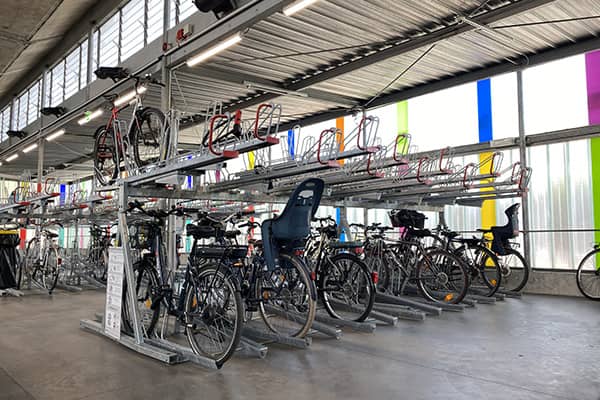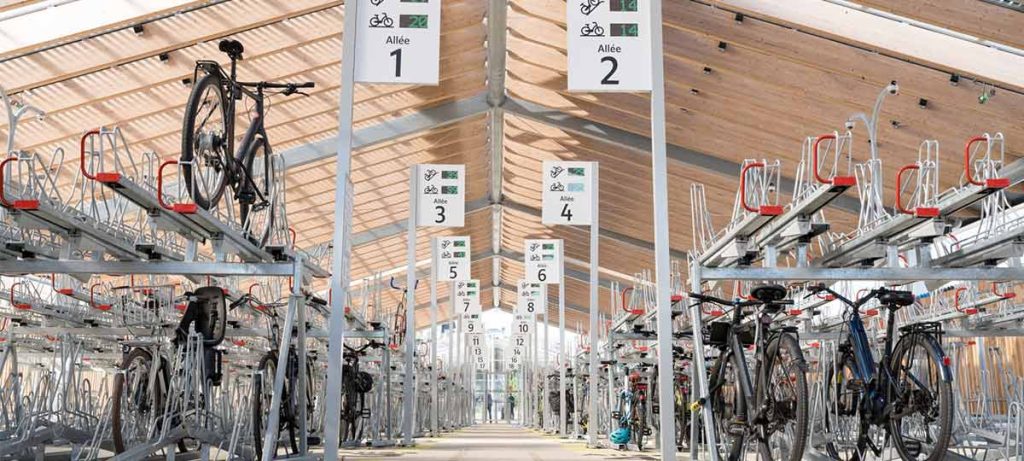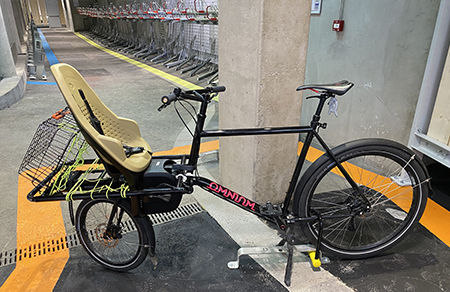
Recent legal requirements reflect a strong commitment from national and European authorities to promote everyday cycling. They demonstrate the conviction that the development of suitable bike parking spaces is a key lever to encourage citizens to use bicycles for their daily travel, thereby actively contributing to the ecological transition of cities.
Bicycle parking regulations for different types of buildings
Decree of 26 December 2022
The decree of 26 December 2022 marks a turning point in regulations on secure bicycle parking in France. It imposes new obligations on new buildings and those undergoing renovation that have car parking facilities.
This text concerns :
- → Housing complexes (collective buildings), industrial and tertiary buildings, public services and commercial complexes.
- → Buildings whose car parks have a capacity of at least 10 car spaces.
- → For each category, it sets minimum thresholds for cycle parking: for example, 1 space per dwelling for homes, and 15% of the workforce for workplaces.
The main aim of this decree is to promote bicycle safety by increasing the number of suitable facilities, while meeting the growing needs of cyclists. It also focuses on the safety of facilities (locking systems, surveillance) and their accessibility.
Energy Performance of Buildings Directive (EPBD) – 2023
The Directive on the Energy Performance of Buildings (EPBD), adopted by the European Commission in 2023, extends the obligation to create cycle parking facilities to existing commercial buildings. Unlike the previous provisions, this directive now applies to all buildings with more than 20 car parking spaces, even if they are not under construction or renovation. The new requirements must be met by 1 January 2027.
In particular, this directive requires :
- → 100 bicycle parking spaces for a building accommodating 1,000 occupants, including spaces suitable for cargo bikes and electrically assisted bicycles (EABs), with integrated electric recharging systems.
Design criteria for parking spaces

Bicycle parking requirements by type of building
New buildings, building permit filed after December 25, 2022:
- 1 bike space per unit for apartments up to 2 rooms,
- 2 bike spaces for apartments with 3 rooms or more.
Existing buildings where the car parking area is undergoing renovation works*:
- 1 bike space per unit.
*If the estimated cost of the works exceeds 2% of the building’s value and the parking area includes at least 10 parking spaces.
New buildings: building permit filed after December 25, 2022.
- 15% of the total number of employees accommodated simultaneously.
Existing commercial buildings, as long as the parking area has at least 10 spaces* for workers.
- 10% of the total number of workers for co-owned buildings,
- or 10% of workers within a co-owner’s premises,
- Mandatory works to be completed before January 1, 2027.
*Even if the parking spaces existed before December 26, 2022.
New buildings: building permit filed after December 25, 2022.
- 15% of the total number of staff members
- and 15% of the users accommodated simultaneously.
Existing buildings where the car parking area is undergoing renovation works*:
- 10% of the total number of staff members
- and 10% of the users accommodated simultaneously.
*If the estimated cost of the works exceeds 2% of the building’s value and the parking area includes at least 10 parking spaces.
New buildings: building permit filed after December 25, 2022.
- 10% of the parking capacity, with a maximum of 100 spaces.
Existing buildings where the car parking area is undergoing renovation works*:
- 10% of the parking capacity, with a maximum of 100 spaces.
*If the estimated cost of the works exceeds 2% of the building’s value and the parking area includes at least 10 parking spaces.
Possible derogations:(See Obligation to install bicycle parking facilities for details).
Accessibility and Security Standards
The layout of bike parking areas must meet certain requirements to ensure accessibility and a minimum level of security. Among the main criteria, a minimum surface area of 1.5 m² per space is required to provide sufficient room for users to maneuver and park their bikes easily. Additionally, racks must be fixed and allow bikes to be stabilized while enabling users to lock the frame and at least one wheel with a lock. This reduces the risk of bikes falling over and provides basic protection against theft.
The security of the parking area is crucial to encourage users to adopt cycling as a mode of transport. One of the main issues surrounding bicycles is the high number of thefts and acts of vandalism they are subjected to.
In this context, although not mandatory, we recommend installing secure doors equipped with effective locking systems, especially in residential complexes and industrial or commercial buildings.
You may also consider investing in video surveillance systems for public-access areas such as commercial complexes, to deter acts of vandalism. Additionally, increasing the human presence can ensure continuous monitoring, particularly in large parking facilities linked to public service buildings.

Adapting to Different Types of Bikes
The needs of cyclists are evolving, and parking spaces must adapt to this diversity. In addition to standard bikes, it is now mandatory to provide spaces for cargo bikes and electric bikes (e-bikes), which require more space and sometimes specific infrastructure. For e-bikes, an appropriate charging system is essential to allow users to recharge their batteries while parked.
It is also important to adapt infrastructure to different bike sizes and shapes. Cargo bikes, often longer and wider, require larger spaces and sturdier racks to ensure their stability. Conversely, folding bikes, although more compact, require flexible solutions for optimal storage.
From new build to upgrading existing buildings
Until the EPBD was adopted, French regulations focused mainly on new buildings and those undergoing renovation. The measures focused on making new projects safer, to encourage cycling right from the design stage.
This 2023 European directive considerably broadens the scope of application, obliging owners of existing tertiary buildings to adapt to the new standards, even without any renovation projects. The aim of this extension is to speed up the adoption of sustainable mobility practices, by making it compulsory to create cycle-friendly infrastructure in buildings that are already in use.
Regulations Supporting Sustainable Mobility
This progressive evolution of standards is part of a broader ecological transition initiative. By requiring all types of buildings to provide bike parking facilities, public authorities aim to:
- → Reduce dependence on cars for short trips.
- → Make it easier for citizens to access more environmentally friendly means of transport.
- → Contribute to the decarbonization of urban mobility, particularly by supporting the use of e-bikes, whose autonomy and daily usage can be enhanced through appropriate charging infrastructure.